

General Information, Bridge History and Details. |
|
The River Thames - Bridge List & Statistics. |
GENERAL INFORMATION, BRIDGE HISTORY AND DETAILS
NOTE: In the following pages, where the heights of bridges are given on the non-tidal Thames, they are measured above the standard head water level of the lock below the bridge with NO allowance being made for the gradient of the River. This is in contrast to bridges on the tidal Thames where heights are given above Mean High Water Springs (MHWS).
In total 106 bridges cross the navigable River Thames below Lechlade. Of the 76 on the non-tidal section, 13 are railway bridges, 46 are road and 17 are footbridges. The lowest is Osney Bridge in Oxford with a height (headway) of only 2.28m (7'5"). The highest bridge is the Maidenhead railway bridge at 9.80m (32'2").
 |
Lechlade (Halfpenny) Bridge |
The first bridge upstream is the Halfpenny (or Town) Bridge at Lechlade which marks the practicable start of the navigable part of the River. It was built in 1792 by James Hollingworth. Following a revolt by local townsfolk in 1839 the half penny toll for pedestrians was lifted.
The last bridge before the start of the tidal Thames is the footbridge across the lock cut at Teddington.
 |
Tower Bridge |
On the tidal Thames there are 30 bridges of which 9 are rail (2 have footpaths attached), 19 are road and 2 are footbridges. The lowest headway is at Hammersmith which is only 3.70m (12'2") high and the highest is the Queen Elizabeth II Bridge at 54.10m (177'6"). Tower Bridge, probably the most famous of all bridges on the River Thames, has a headway of 8.60m (28'3") or 42.5m (139'6") with the bascules up.
All types of bridges (beam, cantilever, truss, arch and suspension) can be seen on the Thames. Similarly there is a mixture of materials and bridges made from wood, brick, stone, cast iron, steel and concrete are all in evidence.
To motorists, cyclists and pedestrians, bridges are a boon giving access, as they do, to towns and villages on both sides of the river. To those of us who use the River, they are a hazard to navigation! Not only do we have to contend with the heights of the bridges but also the currents and eddies that sometimes arise around the bridge supports. Our boat has an air draught of 4.80m (15'9") but this can be reduced to 3.66m (12'0") if we lower the radar arch which we have to do on a fairly regular basis as there are 21 bridges on the non-tidal section that we cannot get under without doing so. This may sound rather daunting but we have got it down to a fine art and can do it in a matter of seconds. We can reduce the air draught further by dropping the Canopy which gives us a height of 3.00m (10'0").
Returning first to the non-tidal River. The oldest bridge is at Radcot which was built in 1225 but this is now over a side stream. The oldest structure over the navigable section is 10 miles downstream at Newbridge which, with its six arches, was built in c.1250 (See details below).
 |
The newest road bridge on the non-tidal River is the Wallingford By-pass bridge which was completed in 1993. |
Wallingford By-pass (Winterbrook) Bridge |
The newest footbridge is Bloomers Hole footbridge, just below St. John's bridge, which was built in 2000. This was the last bridge needed to complete the Thames Path National Trail. The Countryside Agency commissioned Oxfordshire County Council to design and build it. A Chinook helicopter from RAF Brize Norton was used to place the two eight tonne steel beams across the River. Although structurally the bridge is of steel, it has been clad in wood to make it look like a timber structure.
Only two of the bridges that cross the River still have Tolls, Swinford and Whitchurch bridge.
 |
Swinford Bridge (also known as Eynsham Bridge) was built by the Earl of Abingdon in 1769. The architect is not definetly known, but it is thought to be the work of Sir Robert Taylor the designer of Maidenhead road bridge. The bridge has nine stone circular arches, three of which are over the navigation. The central arch is 36 feet wide and the two side arches are 27 feet wide. The 3 floodwater arches on either side are graduated in size and are 24 feet, 20 feet and 16 feet wide respectively. The headway of the central arch is 14' 9'' (4.11m). The toll for cars is 5 pence. |
Swinford (Eynsham) Bridge |
The first two bridges at Whitchurch were of wooden construction and were built in c.1792 and c.1852. The present latticed iron bridge was designed by Joseph Morris and built by the Cleveland Bridge and Engineering Company Ltd in 1902. When we moved to the area in 1979 the toll for a car was 2 pence. Over the years the price has gone up gradually. Now it is 20p though regular users can purchase a swipe card which reduces the price per trip. In 1979 the toll collector stood in the centre of the road in all weathers. Today there is a purpose built kiosk. |
 |
Whitchurch Bridge |
 |
Maidenhead Railway Bridge |
3 of the railway bridges crossing the River were built by Isambard Kingdom Brunel (1806-1859) for the Great Western Railway. The most famous is Maidenhead bridge which was built in 1838. This bridge has the longest, flattest brick arch in the world. It has a span of 39m (128'0") and a rise of only 7.3m (24'0"). It was originally thought that J M W Turner used this bridge in his painting 'Rain, Steam and Speed' but it is now considered that another bridge, nearer London, may have been used.
 |
Gatehampton Bridge |
 |
Moulsford Bridge |
The other two bridges built by Brunel are at Gatehampton and Moulsford. They both have twisted brick arches and are considered as one of the Wonders of the Thames.
Other bridges of interest on the NON TIDAL Thames (with some historical notes), going downstream, are:
ST.JOHN'S BRIDGE
 |
The original single arch stone bridge over the weir, built in 1229 by the local Prior, was one of the earliest stone bridges to cross the Thames. It was extensively repaired in 1820. When the pound lock was built in 1790, a new bridge was built across the lock cut, but by 1795 it was in a state of collapse. Despite it being repaired a number of times in subsequent years, it had to be completely demolished and rebuilt in 1886. |
St. John's Bridge |
BLOOMERS HOLE BRIDGE
 |
Bloomers Hole footbridge, just below St. John's bridge, built in 2000 is the newest footbridge over the river. It was the last bridge needed to complete the Thames Path National Trail. The Countryside Agency commissioned Oxfordshire County Council to design and build it. A Chinook helicopter from RAF Brize Norton was used to place the two eight tonne steel beams across the River. Although structurally the bridge is of steel, it has been clad in wood to make it look like a timber structure. |
Bloomers Hole Footbridge |
The section of the river, over which the bridge is built is called Bloomer's hole though why is not known. Two legends have evolved over the years. On is that a waggoner named Bloomer disappeared into the water whilst crossing with his horse and cart; the other involves the Reverend Bloomer who it is said shocked his parishioners by bathing nude here. |
EATON BRIDGE
 |
| This bridge is of note as it is on the site of Eaton Hastings(also known as Old Hart's Weir) Lock, the last Thames Flash Lock, which survived until 1938. Traces of the weir's concrete edge can be seen upstream of the footbridge.The Anchor Pub once was situated here, but sadly was burned to the ground in 1980. The National Trust, which owns the land decided to let the site go back to nature.There is a footpath from the bridge which leads to the village of Kelmscott with the Plough Pub and Kelmscott Manor, once the home of Willim Morris. |
Eaton Footbridge |
RADCOT BRIDGES
There are two stone bridges at Radcot. As previously mentioned, the Old bridge was built in 1225 and is now over a side stream. It originally had 3 pointed arches but the centre arch was dismantled in 1387 by Henry Bolingbrook (later to become Henry IV) as a trap to catch Robert de Vere who was on his way from Oxford to support Richard II. The centre arch was rebuilt in c.1393 but was built with a rounded arch. A statue of the Virgin Mary that stood on the downstream parapet niche was destroyed during the Civil War.
 |
 |
Older Bridge |
Newer Bridge |
The newer bridge, with its single arch that goes over the navigable River, was built in 1787 by the Thames Commissioners at a cost of £378. It was carefully restored in 1914 by removing and resetting each stone. A lock was also built so that the Old Bridge could be by-passed. The Old Bridge is built of local Taynton stone. It was from here that such stone was sent to London by barge to build St. Paulís Cathedral and other buildings of note in London following the Great Fire in 1666.
OLD MAN'S BRIDGE
 |
Old Man's Bridge is a very narrow footbridge downstream from Radcot Lock, popular with rambers walking a footpath from Faringdon, south of the river to Bampton which is north of the river. According to Thacker, the bridge marks the site of an abolished weir , Harper's Weir. An earlier bridge had disappeared by 1868 and a new bridge built in 1894 |  |
Old Man's Bridge | The narrow footbridge |
TADPOLE BRIDGE
|
Tadpole Bridge is an arched single span bridge built with stone dating from the late 18th century. The Trout Pub, which lies alongside the bridge has mooring available and is very welcoming to boaters. |
 |
Tadpole bridge |
TENFOOT FOOTBRIDGE
 |
Tenfoot is a narrow wooden footbridge, similar in design to Old Man's footbridge further upstream. Its name has nothing to do with its height above water or the width of its span. Thacker thinks it may be linked to a tenfoot weir which once was in the locality and he found mentioned in Jessops Report of 1791 |
Tenfoot Foot Bridge |
SHIFFORD LOCK CUT BRIDGE
|
Shifford Bridge is an unprepossessing wooden bridge with a flat span on concrete supports. |
 |
Shifford Lock Cut Bridge |
NEWBRIDGE
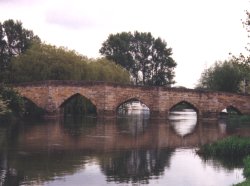 |
Newbridge is the oldest structure over the navigable section of the River. It has six arches and was built in c.1250 but was substantialy re-built in the 15th century. It is called ĎNewí bridge as it was the first bridge to be built after Radcot some 25 years earlier. It is thought that the bridge was built by monks from the priory at Deerhurst using stone from Taynton quarries which was probably transported down the River Windrush which joins the Thames at Newbridge. |
Newbridge |
During the Civil War, the Parliamentarians destroyed part of the bridge to prevent the Royalists escaping from Oxford. In his poem 'The River Thames', John William Pitt wrote:
This bridge has great antiquity, and this belies its name,
For like historic Radcot Bridge, it owes its present fame,
To having been the scene of a stormy battle long ago,
When Charles I was England's King and Parliament his foe.
There is a public house at either end of the bridge: The 'Rose Revived' on the north side and the 'Maybush' on the south side.
HARTíS WEIR FOOTBRIDGE
|
This bridge is of interest to us purely because of its name. The Weir is one of eight flash locks that have at one time or another been known as Hartís. It is not known after which particular family of Harts they were named but it is comforting to know that generations of Harts have been fascinated by the river! |
 |
Hart's Weir Footbridge |
SWINFORD TOLL BRIDGE
 |
Swinford Bridge (also known as Eynsham Bridge) was built by the Earl of Abingdon in 1769. The architect is not definITEly known, but it is thought to be the work of Sir Robert Taylor the designer of Maidenhead road bridge. The bridge has nine stone circular arches, three of which are over the navigation. The central arch is 36 feet wide and the two side arches are 27 feet wide. The 3 floodwater arches on either side are graduated in size and are 24 feet, 20 feet and 16 feet wide respectively. The headway of the central arch is 14' 9'' (4.11m). The toll for cars is 5 pence. |
Swinford (Eynsham) Bridge |
GODSTOW BRIDGE
The old bridge was fought over by the Roundheads and Royalists in the Civil War in 1645. The Royalists held the bridge. The new bridge, built in 1792 over a new navigation channel, has two brick and stone arches and crosses the River at an awkward angle making it a difficult bridge for boats to negotiate. |
 |
Godstow Bridge |
OSNEY ROAD BRIDGE
 |
This single span iron bridge is the lowest on the River with a headway of only 2.28m (7'6") and is the barrier that prevents us, along with many other boaters, from exploring the upper reaches of the Thames beyond Oxford. It replaced a bridge that collapsed in 1885 when an eleven year old girl, Rhoda Miles, was swept away. Her body was not recovered until 1888. |
Osney Bridge |
FOLLY BRIDGE
The original bridge of timber was replaced by a stone bridge in 1085 and the current bridge was built in 1827 to a design by Ebenezar Parry. Two landmarks adjoin the bridge: to one side there is the 'Head of the River' pub and on the other, the head office of Salter Bros, the oldest and most well known passenger boat operator on the River Thames. |
 |
Folly Bridge |
|
Over the years the bridge has had a number of names. In Norman times it was known as South Bridge or Grand Pont. However in the 13th century there was a building next to the bridge used by the Franciscan Friar, Roger Bacon, as an observatory and office and at that time it became known as Friar's Bridge. It kept that name for about 300 years. However, after the Civil War the building was leased to a Mr Welcome who added another storey giving the structure a top heavy appearance and the building became known as Welcome's Folly. It was from this that the bridge acquired its name as Folly Bridge and one that has remained to the present day despite the building, from which it acquired its name, being demolished in 1779. |
|
DONNINGTON ROAD BRIDGE
 |
This reinforced concrete bridge with its 170 ft span, was designed by consulting engineers, R Travers Morgan & Partners and built by The Cementation Company. There is a plaque on the Bridge commemorating its opening by Viscount Hailsham in 1962. |
Donnington Road Bridge |
ISIS ROAD BRIDGE
This single span pre-stressed concrete bridge, was also designed by consulting engineers, R Travers Morgan & Partners and carries the Oxford Ring Road. It was opened in 1962. |
 |
Isis Road Bridge |
KENNINGTON RAILWAY BRIDGE
 |
The current bridge of of six 83 ft long steel bowstring girders is supported on two pairs of cast-iron cylindrical piers each of 8 feet diameter set into the bed of the River. It was opened in 1923 and replaced an earlier iron bridge built in 1864. When it was built it carried the GWR line from Oxford to Princes Risborough. Now one of its main uses is carrying loads of BMW Minis going all over Europe. . |
Kennington Railway Bridge |
NUNEHAM RAILWAY BRIDGE
The first railway bridge here, which carries the Oxford - Didcot railway line, was of timber and built by Isambard Kingdom Brunel in 1844 but this was replaced by an iron bridge in 1856. The current bridge, which dates from 1929, comprises three brick arches at the northern end and two 140 ft steel spans. It gets its name from Nuneham House which can be seen from the River a little further upstream from the bridge. |
 |
Nuneham Railway Bridge |
ABINGDON BRIDGE
 |
This ancient stone bridge, with its eight arches, is very attractive and dates from 1416. Stone for the bridge was a gift of Sir Peter Bessils from his quarry in Sandford. The bridge was largely rebuilt with great care in 1927 by the Counties of Oxford and Berkshire but a contribtion towards the cost was made by The Guild of Christ's Hospital which historically had resposibility for its maintenance. |
Abingdon Bridge |
CULHAM LOCK CUT FOOTBRIDGE
This footbridge over the lock cut carries the public footpath that runs from Culham to Sutton Courtenay. It is of steel girder construction but still looks quite rustic because of its timber balustrade. |
 |
Culham Lock Cut Footbridge |
SUTTON BRIDGE
 |
A bridge at Sutton Courtney was built by Edward Clarke as part of a new road which was completed in c.1810. This coincided with the Thames Commissioners decision to dig a new channel to overcome the difficulties of navigating the River at this point. As a consequence it was neccessary to cut through this recently constructed road and the building, by the Commissioners, of a new 24 ft navigation arch made of blue bricks and concrete. It was completed in 1811 and it is this bridge that stands today. |
Sutton Bridge |
APPLEFORD RAILWAY BRIDGE
Like Nuneham Railway Bridge (which is only about a mile away on the same line) the first railway bridge here, was built of timber by Isambard Kingdom Brunel in 1844 and again this was replaced by an iron bridge in 1856. The current bridge, which dates from 1929, has five segmental brick arches built at the northern end to enable the River to be crossed by a single 167 ft steel span . |
 |
Appleford Railway Bridge |
CLIFTON LOCK CUT BRIDGE
 |
This rustic looking footbridge over the Clifton Lock Cut provides access to the island situated between the cut and the weir stream. |
Clifton Lock Cut Bridge |
CLIFTON HAMPDEN BRIDGE
This graceful brick bridge with six arches was designed by Sir George Gilbert Scott(1811-1878) who will be remembered for his design of the Albert Memorial in London. The bridge was built in 1867 by Richard Casey using local bricks made in kilns in Clifton Heath. It is considered to be one of the most photographed bridges on the River. It has a headway of 4.091m (13'5") under the centre arch . |
 |
Clifton Hampden Bridge |
DAY'S LOCK FOOTBRIDGE
 |
This single span iron bridge, next to the lock keeper's cottage, was built in 1870 and is one of the bridges used for The World Poohsticks Championships. The game is described in A A Milne's book "The House at Pooh Corner", written in 1928, where Pooh Bear and his friends stood on a bridge in the Ashdown Forest and raced twigs on the stream below. The event was started on the Thames in 1983 by Lynn David, the former lock-keeper at Day's Lock, as a fund raising event for the Royal National Lifeboat Institution (RNLI). He put out a box of sticks and a collection box and it soon became an annual event which takes place in March each year. |
Day's Lock Footbridge |
SHILLINGFORD BRIDGE
The current bridge. comprising three stone arches topped by a stone balustrade, was built in 1827. It replaced a timber bridge that was supported on stone piers that was built in 1763. There is some evidence that a bridge existed on this site in c.1300 but there do not appear to be any details about it. It is known however, that there was a ferry at this point between 1379 and 1763. |
 |
Shillingford Bridgee |
WALLINGFORD BRIDGE
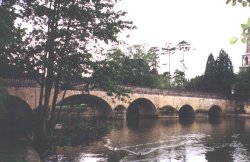 |
Wallingford Bridge is built of stone and has 17 arches although only 5 of them span the River. Three of the arches are Medieval and ribbed, perhaps 13th century, but the middle arches with their handsome balustrade date from 1809 when the bridge was widened by about 1.2m (4'0"). This widening resulted in the arches on the upstream side being rounded whilst those on the downstream side being pointed. The arches to the left and right of these centre arches date from 1751. It has a headway of 5.50m (16'5"). |
Wallingford Bridge |
GORING BRIDGE
This bridge, which is in fact two bridges joined at an island in the middle, links Goring and Streatley and was built in 1923. It is a long, relatively flat, rustic bridge of pleasing appearance. This is an historic Roman and pre-Roman crossing point being the point at which the Icknield Way and the Ridgeway cross the Thames. It is also the route of the more recent Thames Path. It has a headway of 5.15m (16'11"). |
 |
Goring Bridge |
CAVERSHAM & READING BRIDGES
Caversham bridge is one of two bridges that cross the Thames at Reading. It is a twin span concrete structure and was opened in 1926 by Edward, Prince of Wales. It has a headway of 4.57m (15'0"). The main channel passes under the arch nearest the right (southern) bank as the other arch is difficult to navigate through due to the close proximity of Piperís Island.
The first recorded bridge in Caversham was built in 1231 and was of wooden construction. It had a chapel dedicated to St. Anne on an island in the centre which remained there until c.1550. By mid 1800 this bridge, which by then was partly made of brick, had fallen into disrepair and in 1869 a new latticed iron bridge was built which stood until 1924 when they commenced the building of the current bridge. Caversham Bridge played a key role in the Civil War with Charles I and Prince Rupert engaged in a fierce battle against the Earl of Essex.
 |
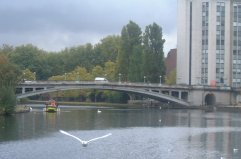 |
Caversham Bridge |
Reading Bridge |
Reading Bridge, nearly half a mile downstream, is the first bridge we go under when travelling upstream from our Marina. It is a single arched concrete structure with a span of 180 feet and has a headway of 5.38m (17'8"). It is the second crossing of the River in Reading. It is a relative newcomer being built in 1923. At that time it was the longest span of its kind and concern was expressed as to whether it could withstand its design load of 293 tons. So confident were the designers that they arranged for a vast number of steam rollers, traction engines and loaded lorries to drive onto the bridge to test it. If the test had failed at that time the consequences would have been catastrophic.
The iron bridge at Caversham could not be demolished until this bridge was completed.
SONNING BRIDGE
 |
This is a very picturesque brick bridge built in c.1775 to replace an earlier wooden bridge built in 1604 and is situated 300m downstream of the lock. For the boater coming down River it is awkwardly placed as the River immediately before the bridge it is sharply curved. It is the first bridge we go under when we leave our marina going downstream. It has a headway of 4.41m (14'6") under the centre arch. |
Sonning Bridge |
SHIPLAKE RAILWAY BRIDGE
The previous railway bridge on this site was built for the Great Western Railway by T H Bertram (Brunel's Assistant), was constructed of timber and was opened in 1857. It carried the branch line from Twyford to Henley.The current bridge had two twin river spans of wrought-iron plate girders supported in the centre of the river on a pair of cast-iron cylinders filled with concrete. It was built by E Finch & Co in 1897. In the 1970s the line was reduced to a single track and the downstream side of the twin span was removed but the brick abutments and central cast-iron pier are still in place. |
 |
Shiplake Railway Bridge |
HENLEY BRIDGE
 |
The previous bridge at Henley, which was a wooden structure on stone foundations, was badly damaged during the Civil War. It was declared unsafe in 1754 when a ferry was introduced as an alternative means of crossing the River. Twenty years later in 1774 it was swept away in a flood. The current Bridge, which was designed by William Hayward, was completed in 1786 using stone from Headington Quarry. It has 5 arches and on either side of the centre arch it has a mask sculptured by Mrs Damer (a relative of Horace Walpole). |
Henley Bridge |
 |
The mask facing upstream is of Isis whilst the mask facing downstream is that of Old Father Thames. The bridge has a headway of 4.34m (14'3") under the centre arch. |
 |
Isis |
Old Father Thames |
HURLEY LOCK CUT FOOTBRIDGES
 |
These two rustic looking footbridges are virtually identical. One is situated upstream of Hurley Lock and the other is downstream. The Thames Path between Temple and Hambleden Locks is on the south side of the River except through the Hurley lock cut where it is on the north side. These two footbridges provide the links between the north and south footpaths. |
 |
Upstream Footbridge |
Downstream Footbridge |
TEMPLE FOOTBRIDGE
 |
This rather elegant wooden footbridge just upstream of Temple lock provides an important element of the Thames Path. It was opened on 24 May 1989 by Lord Hesketh. Before this the Thames Path between Marlow and this point did not follow the River: it went along the road through Bisham. This bridge, which is 150 ft (46 m) long, was built on the line of the Ferry that closed in 1953. |
Temple Footbridge |
MARLOW BRIDGE
 |
Marlow Bridge is an iron suspension bridge built in 1832 by William Tierney Clark and has one of the best visual appearance of any bridge on the non-tidal Thames. It was restored in 1965 by Buckinghamshire County Council when all the ironwork was replaced by steel. It has a headway of 3.86m (12'8"). Clark also designed the suspension bridge over the Danube in Budapest. |
 |
Marlow Bridge from the Riverside |
Marlow Bridge from the Road |
MARLOW BY-PASS BRIDGE
 |
Marlow by-pass bridge was completed in November 1972 and carries the A404 over the River. It has three arches and is 560 feet long. The superstructure is of cantilever design and is constructed of pre-stressed concrete, whilst the piers and abutments were formed in reinforced concrete. The architect was Courtney Theobold and the designers were the bridge engineers of Berkshire and Buckinghamshire County Councils. |
Marlow By-pass Bridge |
BOURNE END RAILWAYAND FOOT BRIDGE
The current bridge replaced an earlier wooden bridge built by T H Bartram, Brunel's assistant and successor. The 'new' three span bridge, designed by J C Inglis, was constructed using 9 feet deep steel lattice girders with mild steel transverse beams supported on two pairs of wrought-iron cylinders 8 feet in diameter and filled with concrete. It was Completed in October 1895. In c.1994/5 a footpath was attached to the upstream side of the bridge to form part of the Thames Path and to replace the Spade Oak Ferry. |
 |
Bourne End Railway and Foot Bridge |
COOKHAM BRIDGE
 |
The current wrought-iron bridge, resting on cylindrical iron piers, was built in 1867 and replaced an earlier wooden bridge built in c.1840. Although tolls were abolished in 1947, the small toll house still remains on the northern bank. |
Cookham Bridge |
COOKHAM LOCK CUT BRIDGE
At only 12' 6" high at its centre, this is one of the lowest bridges on the River Thames below Oxford. We can just get under it without having to lower our canopy. It provides a footpath link from Formosa Island to Cookham Lock and is the only means of access to the lock apart from the River. It is of latticed steel construction but the date it was built is not known. |
 |
Cookham Lock Cut Bridge |
BOULTER'S LOCK BRIDGE
 |
Built across the tail of the lock, this bridge provides access to the adjacent Boulter's Lock Hotel. |
Boulter's Lock Bridge |
MAIDENHEAD BRIDGES
Maidenhead has two bridges, one rail and one road. The railway bridge built by Brunel was described earlier. The road bridge, constructed of stone in 1777, was designed by Sir Robert Taylor(1714-1788) and comprises a series of 13 classical arches topped by a decorative balustrade. It is one of the Riverís best eighteenth century bridges and replaced the original wooden bridge dating from 1298. Taylor also designed part of the Bank of England in Threadneedle Street in London. |
 |
Maidenhead Road Bridge |
M4 MOTORWAY BRIDGE
 |
In 1935 the Ministry of Transport decided to build a bypass around Maidenhead. Work on the bridge, designed by Freeman, Fox & Partners commenced in 1937 and by the outbreak of the Second World War the piers and abutments had been completed. However, the steel for the superstructure was diverted to more pressing needs at that time. When the decision was made to incorporate the bridge as part of the M4 motorway, the opportunity was taken to redesign the superstructure using high-tensile steel plate girders with hollow section cross frames supporting a reinforced concrete deck. In 1959 the Horsley Bridge Company and Thomas Piggot Ltd were contracted to build the bridge which was opened in March 1961. |
M4 Motorway Bridge |
SUMMERLEAZE FOOTBRIDGE
Located in Dorney Reach just upstream of Bray Marina, this simple but graceful footbridge was built in 1992. It is a single span steel bridge with a headway of 24 feet at its centre. |
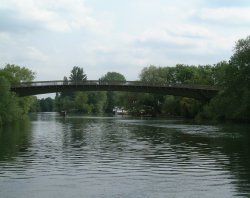 |
Summerleaze Footbridge |
WINDSOR (BY-PASS) BRIDGE
This bridge, also known as the Queen Elizabeth Bridge, was designed by the engineers of Berkshire and Buckinghamshire County Councils in association with the architect Courtney Theobald and is of similar construction to the Marlow By-pass Bridge described earlier. Construction commenced in 1964 and was completed in June 1966. It is 481 feet long and and 82 feet wide. |
 |
Windsor (By-pass) Bridge |
WINDSOR RAILWAY BRIDGE
 |
This bridge carries the railway line from Slough to Windsor and is built on the skew. It was designed by Brunel for the Great West Railway and comprises three parallel wrought-iron bowstring girders each 202 feet long. Each of the three 23 feet high trusses are braced overhead for stability. The approach from Slough is by means of a long brick viaduct which was originally built of timber. The bridge was opened in October 1849 and the main structure is now Brunel's oldest surviving wrought iron bridge. |
Windsor Railway Bridge |
WINDSOR (TOWN) BRIDGE
Windsor Bridge provides a pedestrian link between Windsor and Eton. The construction of the current bridge, built by Charles Hollis (engineer) and Jeffrey Wyatt (architect), was commenced in 1822 and opened in June 1824. The bridge has three cast-iron arches supported on granite piers. The centre arch has a span of 55 feet while the two outer arches each have a span of 43 feet. In 1970 the bridge was closed to vehicular traffic. It has fairly recently been restored. |
 |
Windsor (Town) Bridge |
BLACK POTTS RAILWAY BRIDGE
 |
This bridge, designed for the London and South Western Railway by its own engineer Joseph Locke and built by Thomas Brassy, was opened in December 1849. It has four spans each of 70 feet. Originally each span had six ornate cast-iron arched ribs supported on iron cylinders filled with concrete and then enclosed by brick piers. The ornate arched ribs were short lived as they were found to be fractured and consequently they were replaced in 1892 by the current straight wrought iron plate girders. |
Black Potts Railway Bridge |
VICTORIA AND ALBERT BRIDGES
These two bridges replaced the defunct bridges at Datchet where there had been a crossing of the Thames first as a ferry from 1249 to 1706 and thereafter by bridges. In about 1795 the bridge became unsafe and the ferry was introduced again by George III until 1811 when the Crown used its influence to insist that a new bridge be built by the Counties of Berkshire and Buckinghamshire. However, the Counties could not agree on whose responsibility it was to build it. Nor could they agree upon a design. As a consequence Buckinghamshire built their half in wood whilst Berkshire built their bit in cast-iron and to a completely different design. The Bridge only stood for 40 years when the Prince Regent stepped in to have the Victoria and Albert Bridges built. The two bridges were indentical, with cast iron eliptical spans supported on masonary abuttments. Albert Bridge wes rebuilt in 1928 using ferro-concrete whilst Victoria Bridge was rebuilt in 1967 using two steel boxarch ribs.
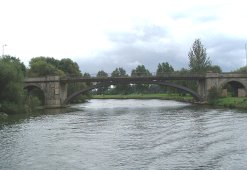 |
 |
Victoria Bridge |
Albert Bridge |
OLD WINDSOR LOCK CUT (HAM) BRIDGE
This bridge, over the so called 'New Cut' to Old Windsor lock, provides vehicular access to Ham Island from Old Windsor and hence its name Ham Bridge. |
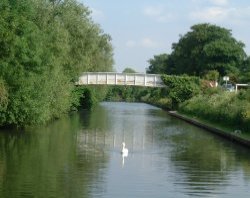 |
Old Windsor Lock Cut (Ham) Bridge |
RUNNYMEDE (A30 & M25) BRIDGES
There are two bridges on this site. The first bridge on the upstream side, was designed by Sir Edward Lutyens (architect) and Mr H W Fitzsimons (engineer) in 1939 to carry the A30 Staines by-pass. However, construction was delayed because of the Second World War. It was finally opened by John Hay MP in November 1961.
 |
The main span of 173 feet is of reinforced concrete and steel and faced with red brick and Portland stone very similar to that found on Lutyens' earlier bridge at Hampton Court. As both the architect and engineer died before the work finally began, their places were taken by G Stewart and C W Glover & Partners. |
The Earlier Upsteam Bridge |
|
When, in the mid 70's, the decision was made for the M25 to cross the River at this point parrallel to the A30 it was decided that a second bridge be built 10 feet further downstream in order to avoid a 200 feet tunnel on this reach of the river which would have been created if the first bridge had been widened. The second bridge, designed by Ove Arup & Partners, has a similar profile to the first bridge but is constructed of four pre-stressed concrete frames with a reinforced concrete arch and deck. Its white cement facing gives it a pleasing appearance. |
 |
The Later Downstream Bridge |
|
Each bridge carries six lanes of traffic. The older bridge carries the northbound carriageways of the A30 & M25 while the newer bridge carries the southbound lanes of the two roads. |
|
STAINES BRIDGE
 |
Staines has quite a history of bridges. It is thought that the Romans first built a bridge here but the first recorded bridge was built in 1222, was of timber, and survived until 1796 when a new stone bridge was built but, almost immediately, it developed cracks. The old wooden bridge was repaired and used again until another bridge, this time of iron construction, was built in 1803. But this bridge collapsed shortly afterwards! The next bridge, of timber and strengthened by cast iron, was built in 1807 but was again short lived. Another new bridge, this time built of granite and designed by Sir John Rennie (1794-1874), the youngest son of John Rennie, was commenced in 1827 and opened by William IV in 1832. This bridge still stands today. |
Staines Bridge |
STAINES RAILWAY BRIDGE
Designed by John Gardner for the Staines,Wokingham & Woking Junction Railway (soon to become part of the London & South Western Railway), it has three 87 feet spans of 8 feet deep wrought-iron plate girders. The two river piers are each comprised of three 6 feet diameter cast-iron cylinders filled with concrete. It was built by Cochrane & Co. and was opened in 1856. |
 |
Staines Railway Bridge |
M3 MOTORWAY BRIDGE
 |
The M3 motorway crosses the River Thames a short distance above Chertsey Lock. The bridge, designed by Posford, Pavry & Partners with Courtney Theobald as consultant architect, is constructed of high tensile steel. It has three spans with the centre span being 210 feet long with a headway of 21 feet 4 inches. The unusual feature of this bridge is the provision of separate east and west bound carriageways at different heights. The two decks, 118 feet wide overall, provide six lanes of carriageway, two hard shoulders and a central reservation. The downstream deck was brought into use in the spring of 1970 but the whole bridge was completed on time in March 1971. |
M3 Motorway Bridge |
CHERTSEY BRIDGE
Chertsey Bridge, designed by James Paine and built by Charles Brown of Richmond, is built of Purbeck Stone and was commenced in 1780. In September 1782 the builder announced that it was complete in accordance with the contract but the 'completed' bridge did not reach the bank at either end. An examination of the contract revealed that it had been built in conformity with the documents but these made no allowance for the fact that part of the river bank had been lost when it was straightened. New contracts therfore had to be entered into for the construction of the approaches. The bridge was finally completed in May 1785. |
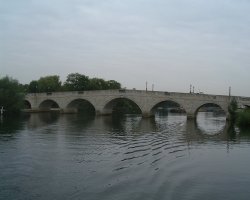 |
Chertsey Bridge |
|
However, the bridge was not well made and settlement of the piers caused the outer walls to bulge resulting in the collapse of the parapet. Soon after, the pedestrian refuges had to be rebuilt. That was not the end of the bridges problems. In 1891 a barge broke from her moorings and hit the bridge. It was first thought that almost all the bridge would have to be demolished and rebuilt but Sir Benjamin Baker (the builder of the Forth Bridge) devised a scheme that meant that only the centre arch had to be reconstructed. |
|
DESBOROUGH CHANNEL BRIDGES
 |
Constructed over the Desborough Channel which was cut in 1930, these two virtually identical bridges provide access to Desborough Island which was formed as a result of the new cut. The bridges were unveiled by Lord Desborough, after whom the channel was named, on 10 July 1935. Extensive repairs to both bridges have been carried out since then. |
 |
Desborough Channel Upper Bridge |
Desborough Channel Lower Bridge |
WALTON BRIDGE
 |
The first bridge at Walton was a wooden lattice structure on stone piers built in c.1748 to replace the Shepperton Ferry. This bridge was shortlived and replaced by another designed by James Paine, the builder of Kew and Chertsey Bridges. It was a brick and stone structure completed in 1750. In 1859 part of this bridge collapsed so in 1864 a new iron lattice girder bridge supported on brick and stone piers was built. This bridge was severely damaged in the Second World War and by 1953 had become unsafe so a 'temporary' bridge was built. This temporary bridge is still in use for pedestrians and cyclists today but in 1999 the current temporary bridge was built for vehicular use. It was designed to last for 10 years. |
Walton Bridge |
Surrey County Council have approved the construction of a new 'Tied Arch' bridge to be built 20 metres upstream from the current temporary bridge. Subject to the outcome of the Public Inquiry in August 2005, it is hoped that construction would commence in November 2006 with completion in March 2009. |
 |
Model of the New Bridge |
SUNBURY LOCK CUT BRIDGE
 |
This bridge, just upstream of the Sunbury Locks, provides access to Sunbury Lock Ait, an island created when the lock cut was first built. It has a headway of 19' 6". |
Sunbury Lock Cut Bridge |
HAMPTON COURT BRIDGE
There has been a crossing of the Thames at Hampton Court, by ferry, for centuries but the first bridge was not built until 1750. It was of wooden construction with 7 arches and looked like the Chinoiserie design of the Willow Pattern. This was later replaced by a more substantial wooden bridge. In 1865 a wrought iron lattice girder bridge was built which was supported on four cast iron columns. It was brought into public ownership in1876. |
|
 |
The present bridge, which was built in 1933 and opened by the then Prince of Wales (later to become the Duke of Windsor), was designed by WP Robinson and Sir Edwin Lutyens (1869-1944). It has three arches (with a headway of 5.92m (19'5") under the centre arch) and is made out of ferro-concrete and clad with red brick and Portland Stone. Sir Edwin Lutyens is an architect of renown who designed, amongst many other public buildings, the Cenotaph in Whitehall and the Roman Catholic Cathedral in Liverpool. |
Hampton Court Bridge |
|
KINGSTON BRIDGE
There have been at least three, if not more, wooden bridges crossing the Thames at Kingston before the current stone bridge was built. The last timber bridge was often in a state of disrepair and as traffic increased across the bridge the more troublesome it became as it was only 12 feet wide. In 1825 a new stone bridge of five elliptical arches was authorised. It was designed by Edward Lapidge and was made of Portland Stone with classical Greek balustrades. It was 382 feet long and at that time 25 feet wide. It was opened by the Duchess of Clarence in July 1828. |
|
In 1906 tram lines were laid across the bridge making it the first Thames Bridge to have trams crossing it. By this time the traffic had increased considerably and with the addition of the trams it made it even more dangerous for pedestrians. The death of a young cyclist made the authorities take action and in 1911 Mott and Hay were engaged to widen the bridge to 55 feet by extending the bridge on the downstream side. They were required to ensure that the original appearance of the bridge would be preserved. The widened bridge opened in October 1914. In 2000 the bridge was widened and strengthened yet again but ths time on the upstream side and its original appearance was preserved once more. It was re-opened by HRH The Duke of Kent on 29 June 2001. |
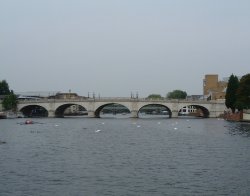 |
Kingston Bridge |
|
KINGSTON RAILWAY BRIDGE
 |
Built for the London & South Western Railway, this bridge comprising of five 75 feet cast-iron arched ribs bolted together is supported on masonary piers. It was designed by J E Errington just before his death and before work commenced. Consequently his place was taken by W R Galbraith. It was built by Thomas Brassey and was opened in July 1863. |
Kingston Railway Bridge |
TEDDINGTON LOCK CUT FOOTBRIDGE
The footbridge, which is just above the lock, was built in 1888/9 and replaced a ferry. Two footbridges of different designs meet on the island at Teddington. The bridge spanning the weir stream from the Teddington bank to the island is a suspension bridge, while the shorter structure crossing the lock cut (shown here) from the Ham bank has a girder design. |
 |
Teddington Lock Cut Footbridge |
To continue with this Bridges page, please Click Here
Copyright © The Harts